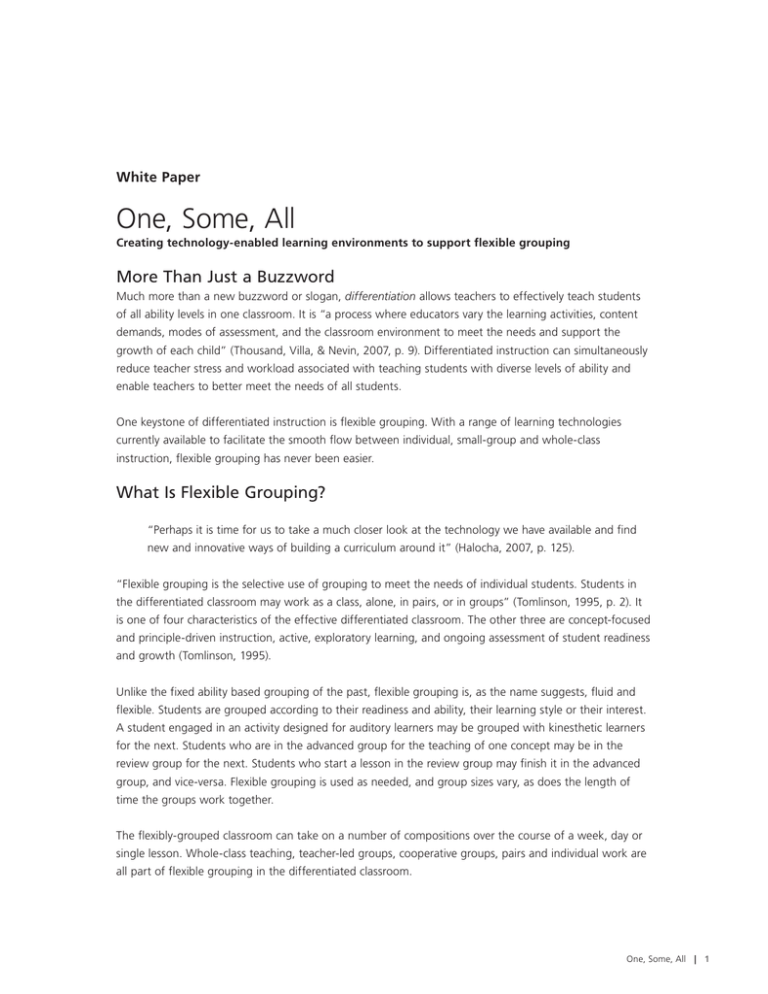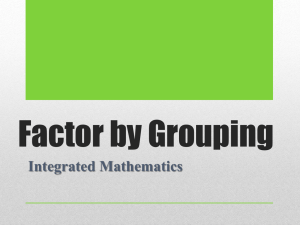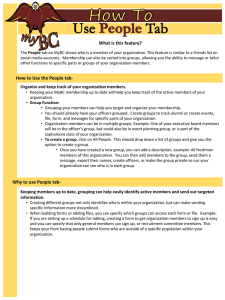
White Paper
One, Some, All
Creating technology-enabled learning environments to support flexible grouping
More Than Just a Buzzword
Much more than a new buzzword or slogan, differentiation allows teachers to effectively teach students
of all ability levels in one classroom. It is “a process where educators vary the learning activities, content
demands, modes of assessment, and the classroom environment to meet the needs and support the
growth of each child” (Thousand, Villa, & Nevin, 2007, p. 9). Differentiated instruction can simultaneously
reduce teacher stress and workload associated with teaching students with diverse levels of ability and
enable teachers to better meet the needs of all students.
One keystone of differentiated instruction is flexible grouping. With a range of learning technologies
currently available to facilitate the smooth flow between individual, small-group and whole-class
instruction, flexible grouping has never been easier.
What Is Flexible Grouping?
“Perhaps it is time for us to take a much closer look at the technology we have available and find
new and innovative ways of building a curriculum around it” (Halocha, 2007, p. 125).
“Flexible grouping is the selective use of grouping to meet the needs of individual students. Students in
the differentiated classroom may work as a class, alone, in pairs, or in groups” (Tomlinson, 1995, p. 2). It
is one of four characteristics of the effective differentiated classroom. The other three are concept-focused
and principle-driven instruction, active, exploratory learning, and ongoing assessment of student readiness
and growth (Tomlinson, 1995).
Unlike the fixed ability based grouping of the past, flexible grouping is, as the name suggests, fluid and
flexible. Students are grouped according to their readiness and ability, their learning style or their interest.
A student engaged in an activity designed for auditory learners may be grouped with kinesthetic learners
for the next. Students who are in the advanced group for the teaching of one concept may be in the
review group for the next. Students who start a lesson in the review group may finish it in the advanced
group, and vice-versa. Flexible grouping is used as needed, and group sizes vary, as does the length of
time the groups work together.
The flexibly-grouped classroom can take on a number of compositions over the course of a week, day or
single lesson. Whole-class teaching, teacher-led groups, cooperative groups, pairs and individual work are
all part of flexible grouping in the differentiated classroom.
One, Some, All | 1
Whole class teaching is a necessary part of flexible grouping. Teachers in the differentiated classroom
convene the whole class for a number of reasons, including introducing new skills and concepts, reviewing
recently learned skills, facilitating group discussion and building community. Whole class instruction is
optimal for reading to the class, sharing writing or problem solving, storytelling and skits and sustained
reading, writing, worksheet, or art projects (Radencich, McKay, & Paratore, 1995).
Small, teacher-led groups are another flexible grouping option. These groups work well for minilessons on specific skills, teacher-led demonstrations and choral reading. In small groups, teachers can
be good watchers, “recognizing what each child can and cannot do, and knowing which child is ready
for a nudge and which child is not” (Radencich, et al., 1995, p. 27). Small, teacher-led groups support
scaffolding, in which students are given the materials and instructional support they need to achieve
beyond their current level; as such, these groups are beneficial for both low- and high-achieving students.
Students in small groups also benefit from more individual attention, and may feel freer to ask questions
and participate in discussion.
Small groups of three to six students can work together without a teacher facilitator. These may be
unstructured discussion groups, or more formal arrangements in which each member has an assigned or
chosen task or role. Groups can be self-selected or assigned based on learning style, interest, readiness
or other criteria. In these groups, students can listen to recorded stories, work on lessons recorded on
the interactive whiteboard, hold writing workshops, work on group projects or presentations or practice
targeted skills. Cooperative grouping builds a sense of both interdependence and individual accountability.
Students who work in cooperative groups “consistently show increased achievement, self-concept, and
social skills” (Radencich, et al., 1995, p. 34).
Pairs, either assigned or self selected, can team up for problem solving, hands-on work, review,
co-writing and research. Peer tutoring, in which a more proficient student teams up with a less proficient
one, can work within the class or across grades, and benefits both parties. In think-pair-share, students
think individually about a question, discuss their thoughts with a partner and present a team response to
the class. Mini-lessons, recorded readings, and interactive-whiteboard recorded lessons are all appropriate
to pair work. Paired learning is easily managed, “can fit effectively into the classroom routine with little
preparation, and can be monitored with ease” (Radencich, et al., 1995, p. 36).
Individual learning has “a vital place in the overall classroom organization” (Radencich, et al., 1995, p. 36).
Individual learning can involve one-on-one teaching to personalize instruction and monitor progress. Or the
student may work independently on practice or extension assignments, reading or writing, studying for tests,
self-assessment, journaling or creative work. Individual work allows students to set goals, select tasks of special
interest explore and extend their knowledge of classroom technology, and reflect on their learning.
Flexible grouping begins with formative assessment, which can be formal or informal, teacher facilitated or
self directed. Assessments are essential in organizing teacher-assigned groups, whether by performance, prior
learning, learning style or interest. Ongoing formative assessments are necessary to ensure, for example, that
students who have mastered a skill can move out of the group that is practicing it. Observation and “the day
to day examination of ‘ordinary’ classwork” (Nagel, 2001, p. 129) are powerful tools for informal assessment:
“Teachers who listen and read with care, document their impressions, and reflect on their data are those
who can gain insight into each child’s learning” (Nagel, 2001, p. 129). Classroom response systems for quick
assessments – formal or informal – offer both students and teachers the benefit of instant feedback.
2 | One, Some, All
How Can Technology-enabled Learning Environments Facilitate
Flexible Grouping?
“The most effective way to help students meet standards is by differentiating your instruction”
(Heacox, 2002, p. 53).
Teachers who have little experience with flexible grouping may find the prospect of organizing and
managing the differentiated classroom daunting. How can teachers spend enough time with all groups
or individuals? Give instructions, answer questions and provide support? Hold everyone’s attention during
whole-class instruction? Control noise and movement? Assess understanding, progress and interest? How
will they find the time to prepare material on whiteboards, flip charts and worksheets?
The answer is to create a technology-enabled learning environment. There are a number of classroom
technology products that teachers can use to facilitate flexible grouping. Computers, interactive whiteboards
and interactive tables allow students to work in groups or alone with limited teacher supervision; interactive
whiteboards can play recorded lessons, instructions or demonstrations; classroom management software
enables teachers to monitor the progress of students working on computers and keep them on task;
wireless slates let teachers control the interactive whiteboard from anywhere in the room; document
cameras project small-scale objects and images to a whole class or group; interactive response systems
can be used for quick formative assessments, and can give students and teachers instant feedback; and
classroom audio systems ensure that instructions, questions and answers reach everyone in the classroom.
These resources can free a teacher from the minutiae of classroom management by enabling students to
work independently with engaging interactive technology, meeting the need “for students and teachers
to be able to flow in and out of a variety of grouping patterns within and across lessons” (Ford, 2005, p.
2). They can save time by giving teachers access to lesson activities, multimedia files and other resources
to aid students’ self-directed learning and to differentiate instruction for their diverse learners.
Following are two examples of how the technology-enabled learning environment can facilitate flexible
grouping in the differentiated classroom:
Example 1 A sixth-grade science teacher begins a unit on flight and aerodynamics that will culminate
in students building and testing various flying devices. First, however, the teacher confirms that students
have a solid grounding in the foundations of experimental design, including developing hypotheses,
controlling variables, and collecting and reporting data – foundations that were introduced in fifth grade.
To differentiate learning by their progress on the learning continuum, the teacher:
• Uses a classroom amplification system to lead a whole-class discussion of experimental design
• Uses a classroom response system to quiz students on their knowledge of the main concepts
of experimental design
• Has students who score 80% or higher on all concepts choose from a list of activities related
to aerodynamics and model building to prepare for the project. Students will have received
instructions and evaluation criteria for these activities on their laptops. For auditory learners,
the teacher will have recorded verbal instructions with text and illustrations on an interactive
whiteboard that students are free to access. Students work independently or in self-selected pairs.
One, Some, All | 3
• Leads a review group for students who score below 80% on all concepts. As they master the
concepts, they are free to leave the group and choose from the list of related activities.
• Has students who score 80% or more on some concepts work independently on concepts
they know, and join the review group to review concepts they need to work on
Example 2 During one week, a third-grade student:
• Worked with three other students to prepare a presentation on volcanoes using, in addition
to the school library, a laptop with wireless Internet access to search for information and
prepare a digital presentation – a project that took three days and culminated in the group
using the interactive whiteboard, digital camera and audio system to present their findings
• With five other students, worked again at the interactive whiteboard, this time on activities to
help them distinguish between long and short vowels (students remained in the group until
they mastered the skill)
• Joined two classmates at the interactive table for a weekly meeting to discuss their home
writing assignments and find pictures to illustrate each other’s stories
• Participated in whole-class instruction at several points during each day, with the teacher using
the interactive whiteboard, interactive slate, student response system and audio system
• Worked on individual activities, both digital (on a laptop) and paper-based, and on arts-andcrafts projects
Flexible grouping in the technology-enabled learning environment
Learning/
Teaching format
Tasks
Whole class
Introducing the day’s activities;
giving an overview of concepts;
explaining or demonstrating
procedures; establishing
background knowledge or context
Interactive whiteboard; laptops;
classroom audio system; document
camera; interactive response
system
Teacher led group
Organizing groups based on
assessment; teaching specific
skills; demonstrating procedures
Interactive whiteboard; laptops;
document camera; wireless slates;
document camera
Student led group
Working on collaborative projects;
following pre-recorded instructions;
discussing responses, solutions,
etc.
Interactive whiteboard; document
camera; wireless slates; interactive
table
Pair
Co-writing; peer tutoring; selftesting and reviewing; responding
to peer writing; collaborative
problem solving
Interactive whiteboard; laptops;
interactive table
Individual
Writing; reading
Interactive whiteboard; laptop;
interactive table
4 | One, Some, All
Benefits of Technology-Enabled Learning Environments
Flexible grouping is one strategy that can help teachers bring the advantages of differentiated
instruction to their classrooms. The primary benefit of this teaching model is that it allows teachers
to meet the needs of diverse students – including visual, auditory and kinesthetic learners, disabled
students, ESL students and gifted students – while the flexible grouping structure means deterministic
labels are avoided.
Differentiated instruction has other advantages as well, as Thousand et al. (2007) argue. It can help
educators meet government targets and mandates, including NCLB and IDEIA in the U.S. and Every
Child Matters in the UK. Differentiation can foster democracy and citizenship in the classroom not only
by including and improving the educational outcomes of students from marginalized groups, but also
by giving students “opportunities to make choices, solve problems among a group, develop consensus,
and deal with conflict of ideas. Students with a great variety of differences can have an effective voice”
(Thousand, et al., 2007, p. 7).
It is when the differentiated classroom becomes a technology-enabled learning environment that
teaching and learning can truly be transformed. “The use of ICT,” writes Halocha (2007, p. 2), “can
change the nature of the learning environment.” The characteristics he attributes to the technologyrich learning environment are precisely those that are most important for today’s learners: engaged
and active learners who are encouraged to inquire and investigate problems, teachers as facilitators
rather than providers of knowledge, the learning environment as a holistic integration of questions,
information and skills, meaningful collaboration and ICT being used to gather, store and analyze
information. Critical-thinking skills, too, are enhanced in technology-enabled learning environments.
“Almost all uses of ICT can place children in positions where they can, at a level appropriate to age
and ability, begin to critically analyze what is being provided through their use of ICT and how it is
affecting their learning (metacognition)” (Halocha, 2007, p. 127).
How to Choose a Technology-Enabled Learning Environment
Today’s learners need whole-class, small-group, and individual learning to prepare them to compete in
the global economy. The ideal technology-enabled learning environment meets the needs of educators
and students in a variety of flexible grouping situations – one, some, or all – and should support smooth
transitions among all three grouping modes.
Educators considering implementing technology-enabled learning environments can use the following
questions as purchasing guidelines:
• Is the technology easy to use for teachers and students? Flexible grouping means giving
students responsibility for using classroom technology. Look for products that are intuitive and
easy to use for teachers and learners alike.
• Are the components customizable? Look for a solution that fits the specific needs of your
classroom or institution, rather than a one-size-fits-all package. The best vendors will assess
your needs and help you to design your own custom technology-enabled learning environment.
• Do the components integrate with each other? A technology-enabled learning
environment based on family of components from a single vendor will save setup time when
changing from one activity or grouping format to another. When the assessment software
integrates with the interactive whiteboard software, for example, and the interactive whiteboard
One, Some, All | 5
with the document camera, the transitions involved in flexible grouping become seamless.
• Is the technology future proof? A scalable technology-enabled learning environment can
grow with its users and with developments in technology. Look for software that offers free
upgrades and hardware with extra connectivity potential.
• Is training available? Effective training is the key to technology adoption. Ask your vendor
for free or affordable training options that meet your needs – individual online training,
downloadable resources, group sessions or train-the-trainer courses.
• Is technical support available? With a range of equipment in use daily in the technologyenabled learning environment, it is important to keep components up and running. Look for a
vendor who offers capable, on-demand technical support.
• Is the technology reliable? In the technology-enabled, differentiated classroom, students
and teachers will handle technology daily. Look for durable, kid-proof products, and avoid
critical components – such as pens for pen-activated interactive whiteboards – that are batterypowered or that can be easily lost or broken. Insist on comprehensive warranties.
Conclusion
A SMART learning environment is an integrated, scalable and future-proof means of bringing
differentiation to the classroom. SMART products support flexible grouping at all levels – whole-class,
group, and individual.
SMART products are well known among educators for their intuitive functionality and ease of use,
supported by a range of flexible training options.
Rugged and reliable, SMART products are used by 18 million students in more than 600,000 classrooms
in more than 100 countries around the world. All SMART products are backed up by warranties and a
variety of online and in-person support resources.
Because every classroom is different, SMART supports customization with its Build your Own Solution
online resource. Take the SMART Classroom Tour (downloads.smarttech.com/media/flash/
classroomtour/index.html) to find out more about SMART technology-enabled learning environments.
To learn more about SMART products and services, visit www.smarttech.com.
6 | One, Some, All
References
Everest, C. (2003). Differentiation, the new monster in education. The Guardian. Retrieved from www.guardian.
co.uk/education/2003/feb/18/furthereducation.uk4/print.
Ford, M. P. (2005). Differentiation Through Flexible Grouping: Successfully Reaching All Readers. Retrieved from www.
learningpt.org/pdfs/literacy/flexibleGrouping.pdf.
Halocha, J. (2007). Using ICT in Teaching. In J. Johnston, J. Halocha & M. Chater (Eds.), Developing Teaching Skills in the
Primary School (pp. 119 –134). Maidenhead, UK: Open University Press.
Nagel, G. K. (2001). Effective Grouping for Literacy Instruction. Boston: Allyn and Bacon.
Radencich, M. C., McKay, L. J., & Paratore, J. R. (1995). Keeping Flexible Groups Flexible: Grouping Options. In M. C.
Radencich & L. J. McKay (Eds.), Flexible Grouping for Literacy in the Elementary Grades (pp. 25 – 41). Boston:
Allyn and Bacon.
Thousand, J. S., Villa, R. A., & Nevin, A. I. (2007). Differentiating Instruction. Thousand Oaks, CA: Corwin Press.
Tomlinson, C. A. (1995). Differentiating Education for Advanced Learners in the Mixed-Ability Middle School Classroom
Retrieved March 7, 2007, from www.kidsource.com/kidsource/content/diff_instruction.html.
This white paper is for informational purposes only, is subject to change without notice and should not be construed as offering any
future product commitments on the part of SMART Technologies ULC. While significant effort has been made to ensure the accuracy
of the information, SMART Technologies ULC assumes no responsibility or liability for any errors, omissions or inaccuracies contained
herein.
© 2009 SMART Technologies ULC. All rights reserved. The SMART logo and smarttech are trademarks or registered trademarks of
SMART Technologies ULC in the U.S. and/or other countries. All other third-party product and company names may be the trademarks
of their respective owners.
One, Some, All | 7




